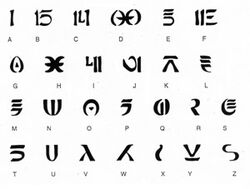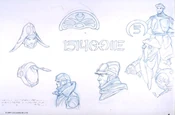| | |

Futhork alphabet
- "In the three and a half millennia since its introduction, it has become as traditional as its more formal cousin, which is now used almost exclusively in military and official capacities."
- ―Milanda Vorgan on the Futhork
Futhork was a style of traditional, handwritten calligraphy used by the Human people of the planet Naboo. This informal writing system had been developed in response to the Futhark—the first Naboo alphabet, which derived from the Royal Script of Grizmallt. While Futhark was the official form, the reliance of all of its letters on ovals made it hard to read. This difficulty led to the creation of the more practical Futhork.[1] The Futhork alphabet contained twenty-six characters,[2] which were usually read from left to right. In that written form, words were distinguished by spaces.[3]
In the height of the New Republic, the use of the Futhork alphabet was already three and a half millennia old.[1] Ancient legends were written in this informal script, including the tale of Veré and Set, two eternal lovers.[4] In the last decades of the Galactic Republic, the art of writing in Futhork was still taught at school, and the six-year-old Ryoo Naberrie, niece of the famous Senator Padmé Amidala, was known to dislike this subject.[5] At that time, even the farmers could write in both Aurebesh—the most universal written form of the Basic language—and Futhork fluently.[6]
The Associate Professor of Xenolinguistics Milanda Vorgan mentioned the Futhork in her paper "The Written Word: A Brief Introduction to the Writing Systems of Galactic Basic." In this work, Vorgan suggested that the Naboo had perhaps been loathe to adopt other writing systems in an effort to barrier themselves from the greater galactic community. However, she illustrated that they did use more widely embraced systems such as Aurebesh in the computer displays of their starships.[1]
The wealthy citizens of Naboo sometimes wore embroidered clothes ornated with Futhork calligraphy.[7] In the same vein, some engineers of the Theed Hangar like Simon Jabesq would label their duty helmet with their name in Futhork letters.[3]
Behind the scenes
Throughout various sources, the word "Futhork" has been spelled variously with[4] or without an initial capital letter.[5] The present article follows The Complete Star Wars Encyclopedia in using the capitalized form.[2]
Creation

Early concept art by Iain McCaig featuring the Futhork letters for A, B, C, D and F
The Futhork alphabet was created for the 1999 movie Star Wars: Episode I The Phantom Menace. It was developed as early as 1997 and was present in a drawing of Naboo helmets by concept artist Iain McCaig.[8] In 2000, the passcodes screen of the LucasArts video game Star Wars: Episode I: Battle for Naboo featured all 26 letters, along with the question mark, the exclamation point and the ampersand.[9] As a result, the mapping of the Futhork alphabet was known from this point on, but the first official transliteration table was not published until 2008, with the release of The Complete Star Wars Encyclopedia.[2]
In real life, Futhork was the name of a runic alphabet used in writing North Germanic languages during the Viking Age—a period spanning roughly the late 8th to 11th centuries.[10]
Examples in products
The mapping of Aurebesh, the most universal and well-known Star Wars alphabet, was only inspired by the inscriptions found in the original movies, and those texts cannot be translated directly.[10] In the case of Futhork, a full symbol-to-letter correspondence seems to have been established from the beginning, since some readouts in this script can be transcribed into intelligible words. For example, the names "Iain,"[8] "Simon,"[3] and "Bernie Jabesq" appear on prop helmets.[8] However, most of the Futhork inscriptions seen in The Phantom Menace either read as gibberish or feature names of people who were part of the movie's production staff, including "Warren Fu."[11]
Likewise, in Star Wars: Episode I The Visual Dictionary, the instances of Futhork used in starship computer monitors only displayed either gibberish or jocular, out-of-universe statements such as "Yo Warren."[3] Similarly, the 1999 interactive CD-ROM Star Wars: Episode I Insider's Guide contains private jokes and allusions such as "Franck Fu is the best."[12] In the roleplaying game guide Secrets of Naboo, four brief Futhork inscriptions were included in the margins. However, they were used for decorative purpose only, and read as "impj," "thk," "uvqx," and "jti."[13]
On the other hand, in Star Wars: Episode II Attack of the Clones, the control panel of Senator Amidala's H-type Nubian yacht featured readable writings in Futhork that made perfect sense in context. Among the readable words are the names of Obi-Wan Kenobi, Coruscant, Geonosis, and Tatooine.[14]
Appearances
- Darth Plagueis
- "A Summer's Dream" — Star Wars Tales 5
- Star Wars: Episode I The Phantom Menace (First appearance)
- Star Wars: Episode I: Battle for Naboo (Only on options-passcodes and the mission's image preview)
- End Game
- Star Wars: Episode II Attack of the Clones
Sources
- Star Wars: Episode I The Visual Dictionary (First identified as Futhork)
- Secrets of Naboo
- Star Wars: The Complete Visual Dictionary
- The Complete Star Wars Encyclopedia, Vol. I ("Futhork")
 The Written Word on Hyperspace (article) (content removed from StarWars.com and unavailable)
The Written Word on Hyperspace (article) (content removed from StarWars.com and unavailable)- The Phantom Menace: The Expanded Visual Dictionary
 Maxiron Agolerga in the Databank (content now obsolete; backup link)
Maxiron Agolerga in the Databank (content now obsolete; backup link) Ryoo Naberrie in the Databank (content now obsolete; backup link)
Ryoo Naberrie in the Databank (content now obsolete; backup link)
Notes and references
- ↑ 1.0 1.1 1.2 The Written Word
- ↑ 2.0 2.1 2.2 The Complete Star Wars Encyclopedia, Vol. I, p. 299 ("Futhork")
- ↑ 3.0 3.1 3.2 3.3 Star Wars: Episode I The Visual Dictionary
- ↑ 4.0 4.1
 Maxiron Agolerga in the Databank (content now obsolete; backup link)
Maxiron Agolerga in the Databank (content now obsolete; backup link)
- ↑ 5.0 5.1
 Ryoo Naberrie in the Databank (content now obsolete; backup link)
Ryoo Naberrie in the Databank (content now obsolete; backup link)
- ↑ "End Game"
- ↑ Darth Plagueis
- ↑ 8.0 8.1 8.2 Star Wars: Episode I Insider's Guide
- ↑ Star Wars: Episode I: Battle for Naboo
- ↑ 10.0 10.1 Runic alphabet on Omniglot (backup link not verified!) Cite error: Invalid
<ref>tag; name "Omni" defined multiple times with different content - ↑ Star Wars: Episode I The Phantom Menace
- ↑ Star Wars: Episode I Insider's Guide
- ↑ Secrets of Naboo
- ↑ Star Wars: Episode II Attack of the Clones
